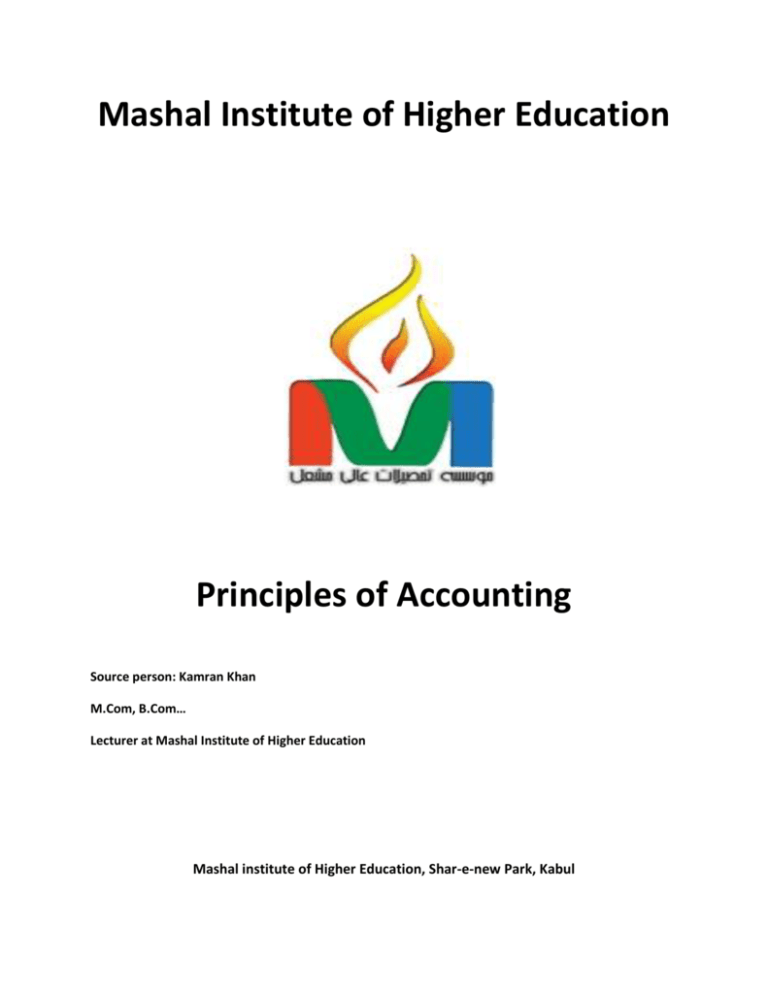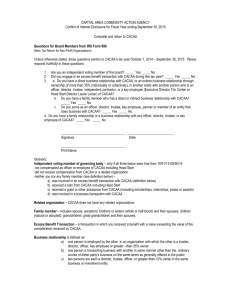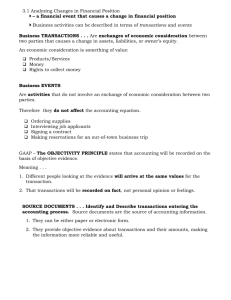Chapter 1 Introduction to Accounting
advertisement

Mashal Institute of Higher Education Figure 1 Principles of Accounting Source person: Kamran Khan M.Com, B.Com… Lecturer at Mashal Institute of Higher Education Mashal institute of Higher Education, Shar-e-new Park, Kabul Chapter 1 Introduction to Accounting Chapter 1 Introduction to Accounting Introduction Accounting is a field of study which is related an entity’s financial matters. In this subject the financial matters of an entity’s is recorded and reported. Accounting is means of measuring an entity’s development. We will not be able to decide whether an organization is improving or declining if we are not account and not having accounting. So, this subject is related with the recording, processing and reporting an entity’s financial activities such as sales, purchases, credit dealings, collections and payments. In all activities (whether business activities or non-business activities) and in all organizations (whether business organizations like a manufacturing entity or trading entity or non-business organizations like schools, colleges, hospitals, libraries, clubs, temples, political parties) which require money and other economic resources, accounting is required to account for these resources. In other words, wherever money is involved, accounting is required to account for it. Accounting is often called the language of business. The basic function of any language is to serve as a means of communication. Accounting also serves this function. Definitions of accounting Accounting has been defined by many authors and authorities. Some definitions are given below to make clear the concept of accounting. Definitions by authors: According to Luca Pacioli, Father of Double-Entry Book Keeping Accountancy is the process of communicating financial information about a business entity to user such as shareholders and managers. According to R.N Anthony, “nearly every business enterprise has accounting system. It is a means of collecting, summarizing, analyzing and reporting in monetary terms, information’s about business”. According to Pride, Hughes and Kapoor Accounting is the process of collection, analyzing and reporting financial information. According to Hrold Q. Lengenderfer “a service activity designed to accumulate, measure and communicate financial information about organizations for decision making purposes” H.Chakravorty: “Accountancy is the science of recording, classifying and summarizing transactions so that relation with outsideers is exactly determined and result of operation during a particular period can be calculated, and the financial position as the end of the period may be shown” Definitions by authorities The American Institute of Certified Public Accountants (AICPA) defines accountancy as "the art of recording, classifying, and summarizing, in a significant manner and in terms of money, transactions and events which are, in part at least, of financial character, and interpreting the results thereof." Summary of the definitions If we summarize the above mentioned definitions, we can say that accounting is a process of collecting financial information of an entity (a person, a department or the government, a nonprofit organization or a business organization), analysis, recording, classifying, summarizing, reporting and interpreting the reported information for a major objective that is the decision making. It shall be remembered that every activity of an entity is not recorded only financial activities of an entity will be recorded, processed and reported means only those activities in which money is involved and affect the entity financially. Previously, accounting was considered as recording process but now a days it is recognized a means to an end means the recording of the business financial information is towards a business decision which is the core objective of accounting today. Basic accounting terminologies Transaction: transaction is an activity of an organization in which the exchange of value is taken place. Transaction is an agreement, communication, or movement carried out between a buyer and a seller to exchange an asset for payment. It involves a change in the status of the finances of two or more businesses or individuals. The buyer and seller are separate entities or objects, often involving the exchange of items of value, such as information, goods, services, and money. It is still a transaction if the goods are exchanged at one time, and the money at another. This is known as a two-part transaction: part one is giving the money; part two is receiving the goods. Types of transaction Transaction has main two types. a. Cash transaction: that transaction which is on cash basis is called cash transaction. Cash transactions are ones that are settled immediately in cash. Cash transactions also include transactions made through cheques. Cash transactions may be classified into cash receipts and cash payments. b. Credit transaction: that transaction which is on account and not on cash basis is called credit transaction. Credit transactions are ones that are settled not in immediate cash payment rather after some agreed time of period say after one or two months. Voucher: Any documentary evidence of a transaction is called voucher. A voucher is an internal documentation which witnesses the happening of a transaction. Cash memo: A documentary evidence of a cash transaction is called cash memo. It is the receipt which shows the sale of products or services. It contains the authenticity of certain product's price sold by the supplier. Invoice: A documentary evidence of a credit transaction is called invoice. Invoice is from a vendor is the bill that is received by the purchaser of goods or services from an outside supplier. The vendor invoice lists the quantities of items, brief descriptions, prices, total amount due, credit terms, where to remit payment, etc Account: A record of a particular item e.g. cash, land, building, salary etc. is called account. Merchandise: merchandise is those items which are purchased for the purpose of resale to customers. These items are not used in the business operations rather they are purchased to resell them in order to earn profit. Merchandise is those items in which a businessman deals. For example, a whole seller who sells the readymade Nokia mobiles is dealing in mobile merchandise. Other examples include sellers deal in readymade furniture, machineries, clothes, shoes, or cosmetics etc all are merchandise. Assets: Items purchased or produced for business use. In financial accounting, an asset is an economic resource. Anything tangible or intangible that is capable of being owned or controlled to produce value and that is held to have positive economic value is considered an asset. Simply stated, assets represent value of ownership that can be converted into cash (although cash itself is also considered an asset) Types of Assets: Assets have the following types. Current Assets: Asset that can be easily converted into cash within one accounting period is termed as current assets. Assets in this category are cash at business, cash at bank, accounts receivable, stock etc. Fixed Assets: Asset that cannot be converted into cash easily within one accounting period is termed as fixed assets. Assets in this category included are land, building, furniture, machinery, computers etc. Intangible: Assets that cannot be touched, weigh, smell or seen but provide some benefit to the organization. Examples are goodwill; copy right, patent right, trademarks etc. Equities: The rights of the owner and outsiders against the assets of the business. The equity may be owner’s equity and liabilities. Owner’s Equity: The investment of an owner in a business or the claim of the owner against the assets of the business. Liability: The debt of the organization or the claim of the outsiders against the assets of the business. Examples of liability are accounts payable, salary payable, bank overdraft, notes payable, salary payable, wages payable etc. Liability may be short-term (liability payable for short period such as a month or a year) or longterm (liability payable long period that is for number of years). Drawings: The cash or items taken by the owner of a business are called as drawing. Drawings are decrease in owner’s equity and it is deducted from the owner’s equity. Expense: to make a payment or incur an obligation for the purchase of an asset, merchandise or service is termed as expense. In case of expense the outlay of cash may take place today or in the settled future. Examples of expense are salary, wages, rent, interest, telephone bill, electricity bill, internet bill, food, travelling and taxes paid. Revenue: price of goods sold is termed as revenue and for service business price of services rendered. Examples of revenue are sales, fee, commission, or interest or rent received. Revenue is different than income. When expenses are deducted from price of goods sold or services rendered, the remaining portion of revenue is termed as income or profit. Professional accountants call it net income or net profit T







